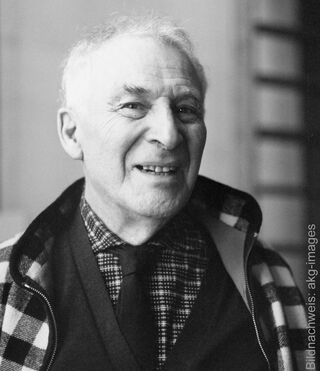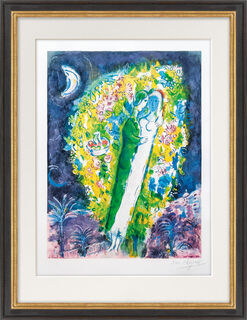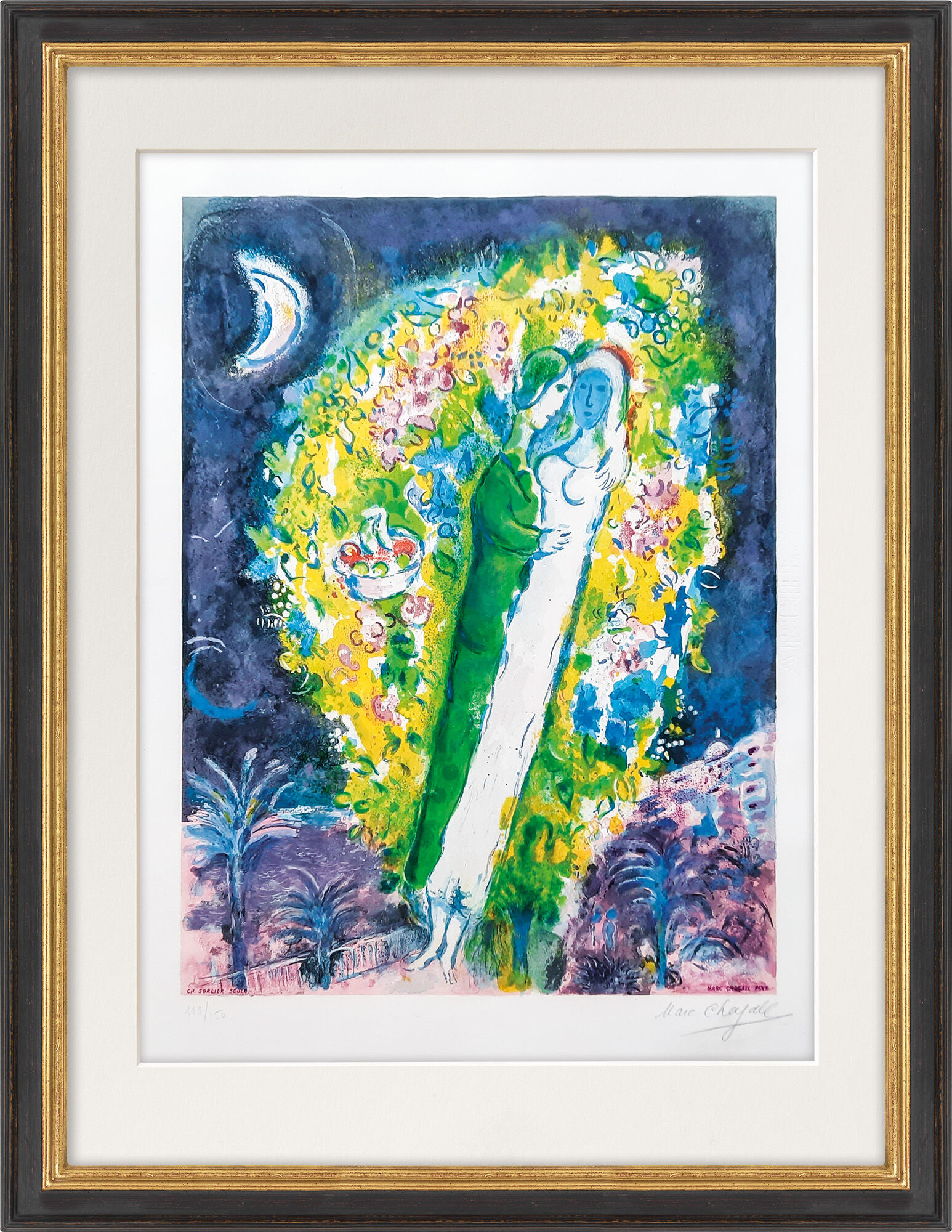Picture "Couple dans les Mimosas" (1967)


Picture "Couple dans les Mimosas" (1967)
Quick info
limited, 150 copies | numbered | signed | colour lithograph on paper | framed | size 87 x 63.5 cm
Detailed description
Picture "Couple dans les Mimosas" (1967)
The colourful lithograph presented here is part of a series of works by Marc Chagall and Charles Sorlier titled "Nice & Côte d'Azur".
Against a moonlit night sky, a couple hugging each other intimately is surrounded by a sea of flowers like a cocoon; the duo of characters seem to have been transported out of time and space by this floral halo.
The glamorous port city of Nice on the Côte d'Azur played a prominent role in the painter-poet's oeuvre and inspired him to create numerous maritime depictions. Since 1973, Nice has been home to the Musée National Marc Chagall, which houses a comprehensive collection of the artist's prints, drawings and paintings and makes them accessible to the public.
Original colour lithograph, 1967. From the series "Nice and the Côte d'Azur". Edition: 150 copies on Arches paper, numbered and signed by hand. Catalogue raisonné Mourlot V CS 32. motif size/sheet size 74.5 x 53.2 cm. Size in frame 87 x 63.5 cm as shown.

About Marc Chagall
1887-1985 - Russian-French painter
Marc Chagall is one of the greatest masters of the 20th century, whose work had a lasting influence on the art world. A unique mythteller of unbelievable creative power - a painter and poet.
The origin of his creations lies in the religious experiences of his childhood, ancient myths and legends. His favourite creatures are enchanted and dreamy figures in love, weightless and removed from reality. The light, open language of signs and the delicate floating of the pictorial motifs develop a charming language of fantasy. The viewer is overwhelmed by the harmony of the theme and the poetic beauty of the colours.
Marc Chagall describes his painting as the "happy vision of a desirable world" and understands it as a counter-image to reality.
Marc Chagall was born in 1887 to Jewish parents in the Belarusian city of Vitebsk. At the age of 20, he went to Saint Petersburg to study painting. There, he saw pictures of European Modernism for the first time and was so fascinated by them that he travelled to Paris in 1910. He rented a tiny workroom in the studio house "La Ruche", where his neighbours were Léger and Modigliani, and he met Soutine, Archipenko and the Delaunays. Chagall lived in the midst of the avant-garde, but he is neither interested in modern technology nor in taking a look ahead, but rather in how he can most effectively capture the nostalgic-poetic world of his childhood memories.
When he saw the colours and forms of the Cubists, he knew: With them, he could use them to depict the enchantment of the small town with its crooked wooden huts, as well as Jewish family celebrations, the frenzy of first love or the flying violinist as a symbol of Ahasver, the restless Jew.
From then on, Chagall playfully fused set pieces of his memories with moments of Russian folklore, religion, nostalgia and fantasy - and succeeded: Herwarth Walden, Berlin art dealer and publisher of the magazine "Sturm," discovered Chagall in 1913 and immediately organised an exhibition in Berlin, making the young artist famous overnight.
Chagall spent the years of the First World War back in Vitebsk. He married his childhood sweetheart Bella Rosenfeld and briefly became "Commissioner for Fine Arts" in 1918, but in 1923 he moved back to Paris with his wife. The young artist was soon doing well in business: He had exhibitions, painted, and illustrated books and in 1930, he received the enormous commission to illustrate the Bible.
In 1941, Chagall and his family fled to the USA. The death of his wife in 1944 interrupted his creative flow for many months. Early nudes and couple paintings express Chagall's deep affection for her with strong erotic symbolism. These works are a hymn to the happiness of human harmony, and they depict the myth of man and woman.
When he returned to Paris in 1947, several European capitals held a retrospective exhibition of the now 60-year-old artist's work. Chagall's early paintings, which transport the viewer into a delicately coloured, non-political ideal world, are popular.
In depicting the ancient love story of "Daphnis and Chloé", Chagall also deals with personal changes in his private life. In 1952, he married the Russian Valentina Brodsky. On the Greek island of Paros, his new life began, that Chagall needed in order to be able to work in a sheltered way. These events are depicted in "Daphnis and Chloé". Spaces of silence alternate with exuberant festivities. But above all hovers the tangible love, detached from the burdens of human existence. Chagall worked intensively on this cycle for three years. The cycle, a series of 42 original colour lithographs, is a masterpiece of illustration in 20th-century art.
In addition to lithographs and bible illustrations, Chagall also created monumental art in public spaces: In the late 1950s, Chagall discovered stained glass. Until the 1970s, he designed windows for numerous large European churches, for a Jerusalem synagogue and the United Nations. At the same time, he created ceiling paintings for the Paris Opera and murals in Tel Aviv, Tokyo and New York. The very old Chagall worked tirelessly - but he was reluctant to talk about his paintings.
The field of graphic arts, that includes artistic representations, which are reproduced by various printing techniques.
Printmaking techniques include woodcuts, copperplate engraving, etching, lithography, serigraphy.


